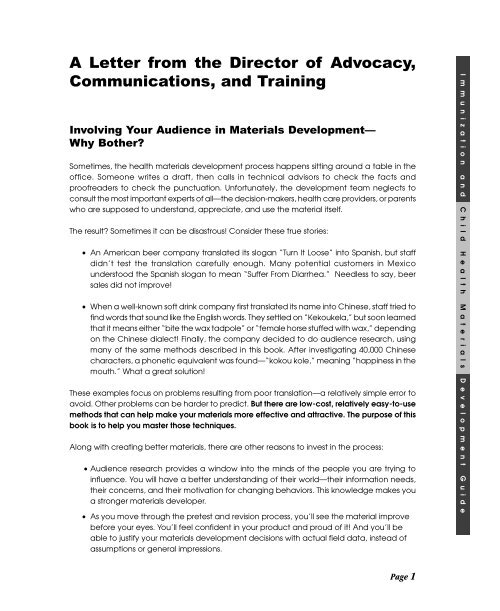Immunization and child health materials development guide pdf
Immunization and child health materials development guide pdf
Immunization and child health materials development guide pdf
Create successful ePaper yourself
Turn your PDF publications into a flip-book with our unique Google optimized e-Paper software.
A Letter from the Director of Advocacy,<br />
Communications, <strong>and</strong> Training<br />
Involving Your Audience in Materials Development—<br />
Why Bother?<br />
Sometimes, the <strong>health</strong> <strong>materials</strong> <strong>development</strong> process happens sitting around a table in the<br />
office. Someone writes a draft, then calls in technical advisors to check the facts <strong>and</strong><br />
proofreaders to check the punctuation. Unfortunately, the <strong>development</strong> team neglects to<br />
consult the most important experts of all—the decision-makers, <strong>health</strong> care providers, or parents<br />
who are supposed to underst<strong>and</strong>, appreciate, <strong>and</strong> use the material itself.<br />
The result? Sometimes it can be disastrous! Consider these true stories:<br />
• An American beer company translated its slogan “Turn It Loose” into Spanish, but staff<br />
didn’t test the translation carefully enough. Many potential customers in Mexico<br />
understood the Spanish slogan to mean “Suffer From Diarrhea.” Needless to say, beer<br />
sales did not improve!<br />
• When a well-known soft drink company first translated its name into Chinese, staff tried to<br />
find words that sound like the English words. They settled on “Kekoukela,” but soon learned<br />
that it means either “bite the wax tadpole” or “female horse stuffed with wax,” depending<br />
on the Chinese dialect! Finally, the company decided to do audience research, using<br />
many of the same methods described in this book. After investigating 40,000 Chinese<br />
characters, a phonetic equivalent was found—“kokou kole,” meaning “happiness in the<br />
mouth.” What a great solution!<br />
These examples focus on problems resulting from poor translation—a relatively simple error to<br />
avoid. Other problems can be harder to predict. But there are low-cost, relatively easy-to-use<br />
methods that can help make your <strong>materials</strong> more effective <strong>and</strong> attractive. The purpose of this<br />
book is to help you master those techniques.<br />
Along with creating better <strong>materials</strong>, there are other reasons to invest in the process:<br />
• Audience research provides a window into the minds of the people you are trying to<br />
influence. You will have a better underst<strong>and</strong>ing of their world—their information needs,<br />
their concerns, <strong>and</strong> their motivation for changing behaviors. This knowledge makes you<br />
a stronger <strong>materials</strong> developer.<br />
• As you move through the pretest <strong>and</strong> revision process, you’ll see the material improve<br />
before your eyes. You’ll feel confident in your product <strong>and</strong> proud of it! And you’ll be<br />
able to justify your <strong>materials</strong> <strong>development</strong> decisions with actual field data, instead of<br />
assumptions or general impressions.<br />
Page 1

















